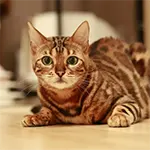The Bengal cat is a domesticated cat breed created from hybrids of domestic cats, especially the spotted Egyptian Mau, with the Asian leopard cat (Prionailurus bengalensis). The breed name comes from the leopard cat’s taxonomic name. Bengals have a wild appearance with large spots, rosettes, and a light/white belly, and are bred to look like exotic jungle cats such as leopards, ocelots, and margays. They possess a richly colored, highly contrasted coat of vivid spots or distinctive marbling.
Origin
Originating in the late 20th century, the Bengal cat was developed to combine the temperament of a domestic cat with the wild appearance of the Asian leopard cat. The first known Bengal cat was produced by a breeder named Jean Sudgen Mill in the 1970s. The breed gained popularity for its exotic looks and energetic personality.
Appearance
Bengal cats are known for their sleek, muscular bodies, broad heads, and large eyes. They are medium to large in size, with males weighing between 10 to 15 pounds (4.5 to 6.8 kg) and females slightly smaller. Their coat is short, dense, and soft, known for its unique markings that include spots, rosettes, and stripes, resembling those of wild cats. The most common colors are brown tabby, seal sepia tabby, seal mink tabby, and seal lynx point (snow Bengal), each with various shades and patterns.
These cats are highly active, playful, and enjoy interaction with their human companions. They are known for their intelligence, curiosity, and affectionate nature, making them excellent pets for families and individuals alike. Bengals are also vocal cats, often making chirping sounds and meowing to communicate with their owners.
Bengals have a few health concerns that potential owners should be aware of, including hypertrophic cardiomyopathy (a heart condition), progressive retinal atrophy (a degenerative eye condition), and susceptibility to infectious diseases due to their varied genetic background. Responsible breeding practices are crucial to minimize these health risks.
Overall, Bengal cats are a fascinating breed that combines the beauty of a wild cat with the friendly disposition of a household pet, making them highly sought after by cat enthusiasts around the world.










